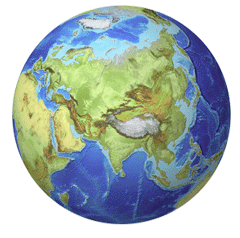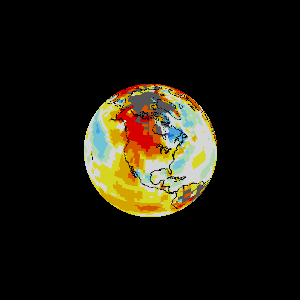Recent findings about global warming driven climate change
climate change literature review
| | recent | media | ocean temperatures | Tibetan glaciers | Adaptive limits | verifying CO2 levels | |
"The release of CO2 from fossil fuel emissions and cement production, and decreasing uptake efficiency of CO2 by land and sea has resulted in the fastest increase in partial pressure of carbon dioxide in the past 800,000 years."
They cite: Luethi, D. et al. Nature, 453, pp. 379-382 (2008).
Nature Climate Change
5:3
March 2015
"Public division about climate change rooted in conflicting socio-political identities"
"Of the climate science papers that take a position on the issue, 97% agree that climate change is caused by humans, but less than half of the US population shares thus belief. This misalignment between scientific and public views has been attributed to a range of factors. . . . The public is divided . . . .The key implication is that the divisions between sceptics and believers are unlikely to be overcome solely through communication and education strategies, and that interventions that increase angry opposition to action on climate change are especially problematic. Thus, strategies for building support for mitigation policies should go beyond attempts to improve the public's understanding of science, to include approaches that transform intergroup relations."
pp. 226-229.
Nature Climate Change
5:3
March 2015
"Saturation-state sensitivity of marine bivalve larvae to ocean acidification"
"Ocean acidification results in co-varying inorganic carbon system variables [pH, partial pressure of carbon dioxide, and aragonite saturation state.]. Of these explicit focus on on pH (acidity) and organismal acid-base regulation has failed to distinguish the mechanism of failure in highly sensitive bivalve larvae. (molluscs, oysters, mussels) . . . . Our findings were repeatable. . . and suggest a fundamental ocean acidification bottleneck at early life history for some marine keystone species."
"First there is limited remaining capacity for Oregon's coastal waters to absorb more CO2 before sub-lethal thresholds are crossed for bivalve larvae. Increasing atmospheric CO2 pushes saturation state across these thresholds more frequently and with greater magnitude in the California Current . . . Second, these saturation state thresholds will be crossed long before recently documented pH changes found to be physiologically important for molluscs." This would mean a there is evidence "for a mechanism by which transient, moderate acidification impacts nearly resulted in collapse of the Pacific Northwest oyster fishery."
pp. 273-280
Nature Climate Change
3:11
November 2013
"The role of coastal plant communities for climate change mitigation and adaptation."
Marine vegetated habitats (seagrasses, salt-marshes, macroalgae, and mangroves) occupy 0.2% of the ocean surface, but contribute 50% of carbon burial in marine sediments. Their canopies dissipate wave energy and high burial rates raise the seafloor, buffering the the impacts of rising sea level and wave action that are associated with climate change. The loss of a third of the global cover of these ecosystems involves a loss of restoration and use of vegetated coastal habitats in eco-engineering solutions CO2 sinks and the emission of 1PG CO2 annually." (p.961)
pp. 961-968.
Nature Climate Change
3:11
November 2013
"Global warming amplified by reduced sulphur fluxes as a result of ocean acidification."
"Climate change and decreasing seawater pH (ocean acidification) have widely been considered as uncoupled consequences of the anthropogenic CO2 perturbation. Recently, experiments in seawater enclosures (mesocosms) showed that concentrations of dimethylsulphide (DMS), a biogenic sulphur compound, were markedly lower in a low-pH environment. Marine DMS emissions are the largest natural source of atmospheric sulphur and changes in their strength have the potential to alter the Earth's radiation budget." (p.975.)
pp. 975-978.
Nature Climate Change
2:9
September 2012
"Communication of climate projections in US media amid politicization of model science."
"Computer models generate projections of future climatic conditions that lie at the crux of climate change science and policy, and are increasingly used by decision makers Yet their complexity and politicization can hinder communication of their science, uses, and limitations. Little information on climate models has appeared in US newspapers over more than a decade. Indeed we show it is declining in relative to climate change. When models appear, it is often within skeptic discourses. . . . We find that model projections were frequently portrayed as likely to be inaccurate. Political opinion outlets provided more explanation than many news sources."
The value of context in media is important. Yet "when most of the US public is already either confused about or skeptical of the reliability of climate models in projecting future climate conditions, providing greater access to sources of explanatory content other than opinion and political commentary may assist in helping individuals to overcome lay mental models of the science and better comprehend this form of science inference, with implications for their consideration of policy responses Audience-tested explanatory texts about climate models, their uses and their limitations thus should be an important component of public communication about climate science and policy."
pp. 648-653.
Nature Climate Change
2:9
September 2012
"Reconciling disparate twentieth-century Indo-Pacific ocean temperature trends in the Instrumental record"
"Large discrepancies exist between . . . sea surface temperature trends determined form present reconstructions. These discrepancies prevent an unambiguous verification and validation of climate models used for projections of future climate change. Here we demonstrate that a more consistent and robust trend among all he reconstructions is found by filtering each data set to remove El Nino / Southern Ocean Oscillation (ENSO), which is represented not by a single-index time series but rather by an evolving dynamic process. That is, the discrepancies seem to be largely the result of different estimates of ENSO variability in each reconstruction. The robust ENSO-residual trend pattern represents a strengthening of the equatorial Pacific temperature gradient since 1900, owing to a systematic warming trend in the warm pool and a weak cooling in the cold tongue. Similarly, the ENSO-residual trend in sea-level pressure represents no weakening of the equatorial Walker circulation over the same period." The Walker circulation is an atmospheric turnover of tropical air along a narrow equatorial band characterized by rising warm air and rainfall on one side and falling, clear, drier air on the receiving side of the pattern.
"Given the impact of sea-surface temperature (SST) anomalies in the tropical Indo-Pacific on climate worldwide, identifying systematic and predictable externally forced trends in the region is essential to future regional climate-change projections" (variability). . . ." How the tropical Pacific will respond to an increase in greenhouse gases has significant implications for global climate change."
The implication of the article is that "The importance of this robust ENSO-residual pattern for long-term climate change extends beyond the tropics." The "1998-2002 tropical SST anomalies" . . . "were coincident with widespread mid-latitude drying, where both eastern equatorial Pacific (South America) cold SST anomalies and warm Indian ocean and warm pool SST anomalies contributed to the drying over North America, southern Europe and southwest Asia."
pp. 691-699.
Nature Climate Change
2:9
September 2012
"Different glacier status with atmospheric circulations in the Tibetan Plateau and surroundings"
"The Tibetan Plateau and surroundings contain the largest number of glaciers outside the polar regions. These glaciers are at the headwaters of many prominent Asian rivers and are largely experiencing shrinkage, which affects the water discharge of large rivers such as the Indus. The resulting geohazards merit a comprehensive study of glacier status on the Tibetan Plateau and surroundings. Here we report on the glacier status over the past 30 years by investigating the glacial retreat of 82 glacier, area reduction of 7.090 glaciers and mass-balance change of 15 glaciers. Systematic differences in glacier status are apparent from region to region, with the most intensive shrinkage in the Himalayas (excluding the Karakorum) characterized by the greatest reduction in glacial length and area and the most negative mass balance. . . . In addition to rising temperature, decreased precipitation in the Himalayas and increasing precipitation in the eastern Pamir accompanied by different atmospheric circulation patterns is probably driving these systematic differences.'
"Potential consequences of glacier changes would be unsustainable water supplies from major rivers and geohazards ( glacier-lake expansion, glacier-lke outbursts, and flooding) which might threaten the livelihoods and wellbeing of those in downstream regions."
pp. 663-667.
Nature Climate Change
3:4
April 2013
"Limits to adaptation"
As adaptation is more heavily relied upon to reduce the "growing risks of climate change" rather "little is known about limits in social systems–whether there are social limits to adaptation. . . ."
"Many communities in highly vulnerable regions like the Arctic are already facing limits in their capacity to adapt and losses that are difficult to compensate for."
"Research suggests that opportunities and resources to adapt may be finite for many social actors, whether these are individual households, businesses, or government."
pp. 305-307.
Nature Climate Change
3:5
May 2013
"Atmospheric verification of anthropogenic CO2 emission trends"
"International efforts to limit global warming and ocean acidification aim to slow the growth of atmospheric CO2 guided primarily by national and industry estimates of production and consumption of fossil fuels. Atmospheric verification of emissions is vital but present global inversion methods are inadequate for this purpose. We demonstrate a clear response in atmospheric CO2 coinciding with a sharp 2010 increase in Asian emissions but show persisting slowing mean CO2growth from 2002/03."
"As atmospheric emissions are predominantly located in the Northern Hemisphere, . . . changes in Northern Hemisphere emissions may be detected more promptly. . . ."
pp. 520-524.
| | recent | media | ocean temperatures | Tibetan glaciers | Adaptive limits | verifying CO2 levels | |
Terms
 The Walker circulation of air is an lateral geographical condition of the air due to an atmospheric anomaly associated with rising moist air carrying rain and falling drier air in a dependent circular pattern. The rising and sinking branches are climatologically anchored to specific geographical locations, but these locations shift seasonally. In winter the the rising branch is centered near the "maritime continent" of greater Indonesia while in summer it is centered near southern India. The sinking branches are generally found in the eastern equatorial Pacific in winter and summer. Sub-branches of rising motion are generally tied to equatorial areas of South America and Africa in summer.
The Walker circulation of air is an lateral geographical condition of the air due to an atmospheric anomaly associated with rising moist air carrying rain and falling drier air in a dependent circular pattern. The rising and sinking branches are climatologically anchored to specific geographical locations, but these locations shift seasonally. In winter the the rising branch is centered near the "maritime continent" of greater Indonesia while in summer it is centered near southern India. The sinking branches are generally found in the eastern equatorial Pacific in winter and summer. Sub-branches of rising motion are generally tied to equatorial areas of South America and Africa in summer.| | recent | media | ocean temperatures | Tibetan glaciers | Adaptive limits | verifying CO2 levels | |
Archer conclusion | Christianson | Gelbspan | James Hansen, 04 : Hansen 06 | McKibben| Schmidt | Weart | Wigley


